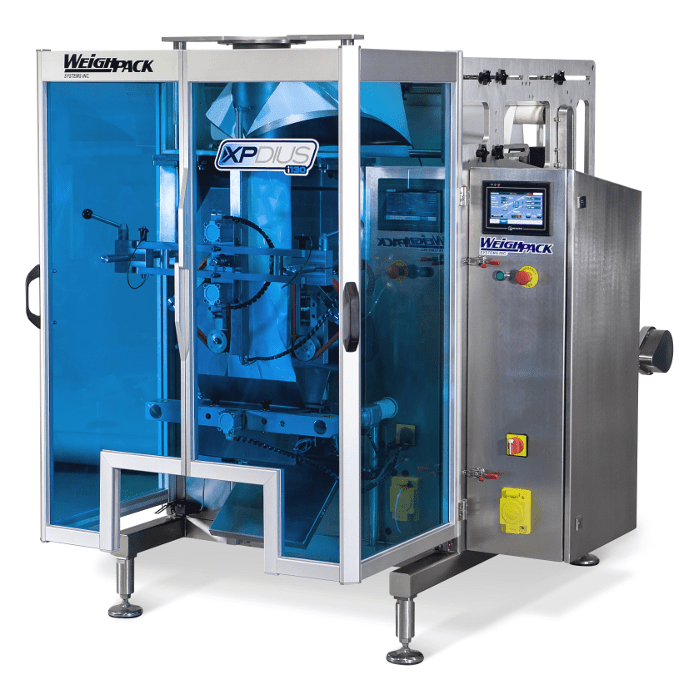At WeighPack Systems we manufacture a wide range of vertical form, fill and seal machines otherwise know as vertical baggers, VFFS or VFS machines.
Our models include:
- VerTek 800 vertical form fill & seal for producing pouches up to 8 inches wide
- VerTek 1200 vertical form fill & seal for producing pouches up to 12 inches wide
- VerTek 1600 vertical form fill & seal for producing pouches up to 16 inches wide
- VerTek 2400 vertical form fill & seal for producing pouches up to 24 inches wide
- XPdius Elite i-130 vertical form fill & seal for producing up to 100 pouches per minute
At a macro level, a vertical form, fill and seal machine uses flat roll stock film on a roll and forms that film into a cylinder then sealing the back (vertical seal) and top seals (horizontal seal) into a pouch.
Companies often choose and use vertical form fill and seal machines for several reasons:
1. Purchasing roll stock film as opposed to pre-made pouches is the least expensive way to package as you are no longer paying for a value added product.
2. Vertical bagging machines tend to be very compact
3. Vertical form fill machines are typically easy to use and require little maintenance.
4. Packaging vertically with gravity allows for higher production rates which is why this form of packaging is very common in packaging commodity like products.
In further detail from: https://en.wikipedia.org/wiki/Vertical_form_fill_sealing_machine
For a vertical form-fill-seal the film approaches the back of a long hollow conical tube, which is called the forming tube. When the center of the plastic is near the tube, the outer edges of the film form flaps that wrap around the conical forming tube. The film is pulled downward around the outside of the tube and a vertical heat-sealing bar clamps onto the edges of the film to create the “fin Seal”, bonding the film by melting the seam edges together.[4]
To start the bagging process, a horizontal sealing bar creates the “Bottom Seal” by clamping across the bottom edge of the tube, bonding the film together, and cutting off any film below. This sealing bar can be on a fixed height, which is called an intermittent sealing process. Faster systems include a sealing bar that moves down with the bag while sealing. This is called a continuous process. The product is either pre-measured by a multi-head weighing system or the sealed tube end is then lowered onto a precision weighing table and the product to be bagged is dispensed through the long conical tube in the center of the bag. When the gross weight of the product-filled bag is reached, filling stops, and the horizontal sealing bar seals the top of the bag, simultaneously forming the bottom of the next bag above. This bag is then cut off from the tube and is now a sealed package, ready to advance onward into the product boxing and shipping processes.
During the final sealing process, the bag may be filled with air from a blower or from an inert gas supply such as nitrogen. Inflating the bag helps reduce the crushing of fragile products such as potato chips, while inflating with inert gas helps drive out oxygen and retards the growth of bacteria that would spoil the product. Other product finishes such as hole punching for retail hanging racks will be done concurrently or just after the “Top Seal” is made.
The feeding of material and cutting of the bag/pouch can be determined either by pouch length, or by indexing to an eyespot (photo registration mark), which is detected by a visual sensor. While single web systems are popular for food applications, the dual web four side seal system is often popular for IVD and Medical device products. Closely related is the horizontal form-fill-seal machine, which generally uses more floor space than a vertical system. Modern advancements in pouch forming technology have allowed for smaller and smaller Vertical pouch forming systems.
Many food filled packages are filled with nitrogen to extend shelf life. Food manufacturers are often looking for ways to improve their geographical reach or otherwise extending the shelf life of their product without the use of chemicals. Nitrogen filling is a natural means of extending shelf life. More and more manufacturers are choosing to create and control their own nitrogen supply by using an on demand nitrogen generators.
References
“VFFS History and current market, Vertical Form Fill Seal machine | TripleMExpo”. TripleMExpo. Retrieved 2016-06-10.
“Vertical Form Fill Seal”. www.econo-pak.com. Retrieved 2016-06-10.
Yam, Kit L. (2009). The Wiley Encyclopedia of Packaging Technology, 3rd Edition. John Wiley & Sons. p. 546. ISBN 978-0-470-08704-6.
Soroka, W. (2002). Fundamentals of Packaging Technology. IoPP. ISBN 1-930268-25-4.
